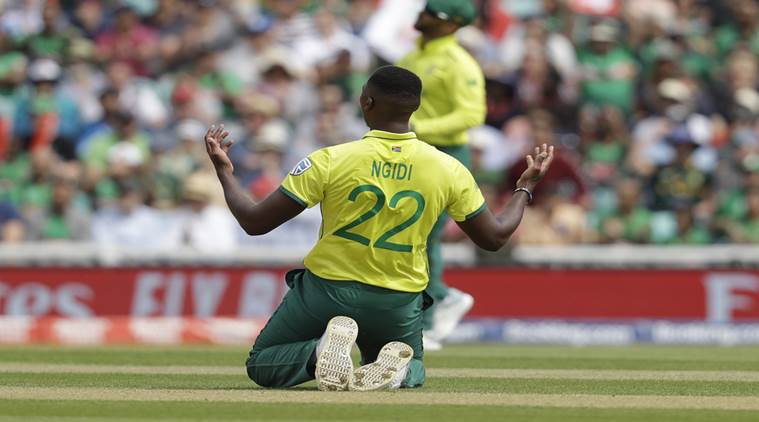
Two losses on the spin, and South Africa are already on the edge. Against England in the first game, South Africa had conceded 311 in 50 overs and it was even worse against Bangladesh, where they were hammered for 330. Former South Africa fast bowler Fanie de Villiers is of the opinion that the Saffers have suffered from bowling a little too straight on placid pitches in the first two games. They need to change their line of attack in the must-win contest against India.
“Let’s hope it’s just two games that have gone wrong. But I can see a lot of guys are bowling a little too straight and they can’t keep their length right. And the moment you lose your line and length, you will go for 60-70 runs in 10 overs. And that’s a losing score you chase the moment your bowlers go for that,” de Villiers told The Indian Express on the eve of the India-South Africa game. Collectively, the five South Africa fast bowlers/medium pacers — Kagiso Rabada, Lungi Ngidi, Andile Phehlukwayo, Dwaine Pretorius and Chris Morris – have given away 434 runs in 69 overs – 218 in 35 overs against England and 216 in 34 overs against Bangladesh — in two matches.
READ | Question South Africa is asking: Will the real Rabada stand up?
Take the case of Rabada; against England, 16 times he had been hit on the leg side for one to three runs, while thrice the ball went to the fence. Rabada returned with 2/66 from 10 overs. Ngidi, on the other hand, was milked on the leg side for one to three runs by the England batters eight times, while he also conceded four leg side boundaries. Nigidi’s figures read, 3/66 from 10 overs. Phehlukwayo — 1/44 in eight overs — had been accounted for one to three runs on the leg side by the Poms 16 times, although the medium pacer gave away just one leg side boundary. Seaming-allrounder Pretorius — 0/42, seven overs — had been marginally better line-wise, getting clipped for one to three runs on the leg side by the England batters 11 times and conceding one leg side four.
“The reality is if one is to find a fault, they (bowlers) are not performing to their stats, to their averages. And if you are not performing to those averages, then there’s a problem somewhere. And the management has to find out what that is. You can’t point too much fingers at batting. First game they didn’t do well. Second game they scored 300 runs. For two games the bowlers were expensive,” de Villiers added.
Against Bangladesh, Rabada improved with regard to line. One to three runs had been scored to his bowling on the leg side just six times and he gave away only one leg side boundary. He went for under six runs per over in that game — 0/57 in 10 overs – although he didn’t pick a wicket.
Ngidi bowled just four overs – 0/34 – before picking up an injury, but yet again he either bowled a little too straight or strayed down the leg side. Four leg side boundaries in as many overs attested that.
Phehlukwayo, too, improved — 2/52, 10 overs. He conceded one leg side boundary against Bangladesh. But 13 hits for one to three runs on the leg side showed inconsistency. Chris Morris, Pretorius’s replacement, was poor — 2/73 in 10 overs. He had been accounted for one to three runs on the leg side 19 times on top of five boundaries that he conceded in that region.
“Everybody has been telling our players that they are the best bowling attack in the world. Everybody has been telling them how good they are and how wonderful they are, and they can bowl out the opposition to any total or defend any total. I’m afraid to say in South Africa, we get away with fast pitches. We get away with bad deliveries that can’t get hit because of our faster tracks in South Africa. On slower tracks, obviously the mistakes are coming to the fore,” de Villiers said.
De Villiers’s economy rate in 83 ODIs that he played between 1992 and 1997 had been a miserly 3.57. As Faf du Plessis and company gear up for the match against India, he advised the present team management to be a little “conservative” in their bowling approach.
“…if we analyse the bowling, just by bowling a little bit more conservative, not attacking too much, which means bowling at fifth-sixth stump outside the off stump, I reckon the guys can go for 50 runs or so less in their (collective) bowling spells. And that can obviously helps us chase a score less than 300. If that’s the case, then you have got a chance to beat India. And the moment you beat India, which is possibly the strongest team in the World Cup, then everything can change. Because, your mental capacity as a cricket player is a very strong entity and that can change rapidly.
“So yes, it’s a hell of an opportunity. To play the best team in the World Cup and hopefully beat them and show everybody, even the negative criticism coming from old players like me, that they can rectify and they can play better cricket. So if I’m them, I would make sure the strategy is right for the Indian side to beat them to be back in the running again.”